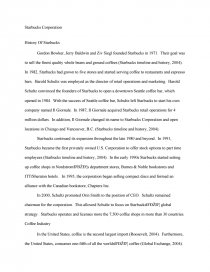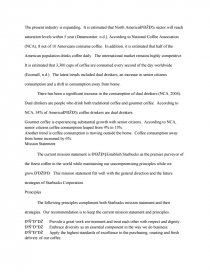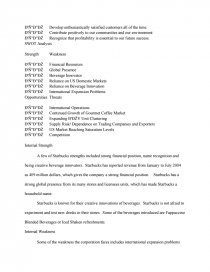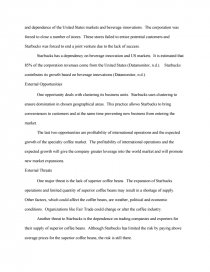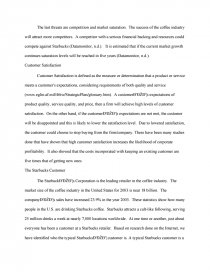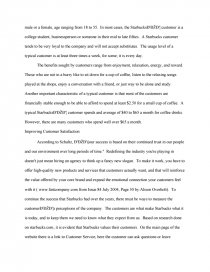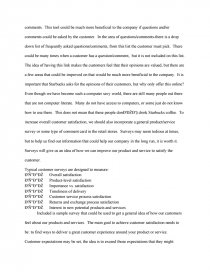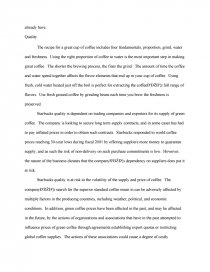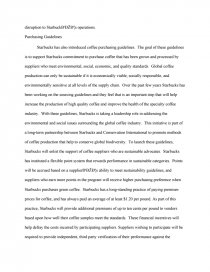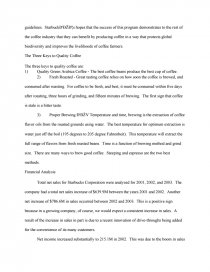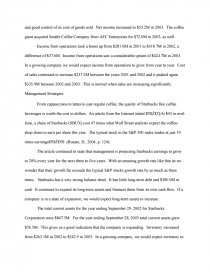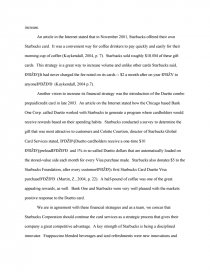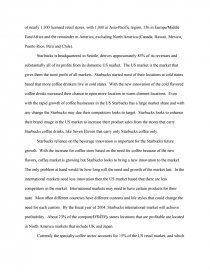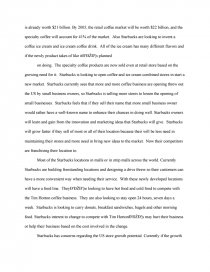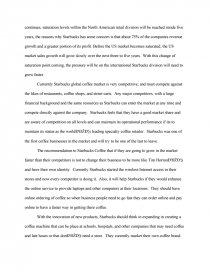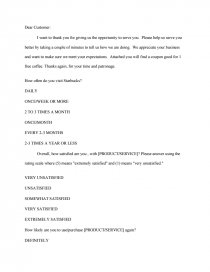Starbucks Corporation
Essay by review • February 6, 2011 • Case Study • 5,475 Words (22 Pages) • 3,618 Views
Starbucks Corporation
History Of Starbucks
Gordon Bowker, Jerry Baldwin and Ziv Siegl founded Starbucks in 1971. Their goal was to sell the finest quality whole beans and ground coffees (Starbucks timeline and history, 2004). In 1982, Starbucks had grown to five stores and started serving coffee to restaurants and espresso bars. Harold Schultz was employed as the director of retail operations and marketing. Harold Schultz convinced the founders of Starbucks to open a downtown Seattle coffee bar, which opened in 1984. With the success of Seattle coffee bar, Schultz left Starbucks to start his own company named Il Giornale. In 1987, Il Giornale acquired Starbucks retail operations for 4 million dollars. In addition, Il Giornale changed its name to Starbucks Corporation and open locations in Chicago and Vancouver, B.C. (Starbucks timeline and history, 2004).
Starbucks continued its expansion throughout the late 1980 and beyond. In 1991, Starbucks became the first privately owned U.S. Corporation to offer stock options to part time employees (Starbucks timeline and history, 2004). In the early 1990s Starbucks started setting up coffee shops in NordstromÐ'ÐŽÐ'¦s department stores, Barnes & Noble bookstores and ITT/Sheraton hotels. In 1995, the corporation began selling compact discs and formed an alliance with the Canadian bookstore, Chapters Inc.
In 2000, Schultz promoted Orin Smith to the position of CEO. Schultz remained chairman for the corporation. This allowed Schultz to focus on StarbucksÐ'ÐŽÐ'¦ global strategy. Starbucks operates and licenses more the 7,500 coffee shops in more than 30 countries.
Coffee Industry
In the United States, coffee is the second largest import (Roosevelt, 2004). Furthermore, the United States, consumes one-fifth of all the worldsÐ'ÐŽÐ'¦ coffee (Global Exchange, 2004). The present industry is expanding. It is estimated that North AmericaÐ'ÐŽÐ'¦s sector will reach saturation levels within 5 year (Datamonitor. n.d.). According to National Coffee Association (NCA), 8 out of 10 Americans consume coffee. In addition, it is estimated that half of the American population drinks coffee daily. The international market remains highly competitive. It is estimated that 3,300 cups of coffee are consumed every second of the day worldwide (Ecomall, n.d.). The latest trends included dual drinkers, an increase in senior citizens consumption and a shift in consumption away from home.
There has been a significant increase in the consumption of dual drinkers (NCA, 2004). Dual drinkers are people who drink both traditional coffee and gourmet coffee. According to NCA, 54% of AmericaÐ'ÐŽÐ'¦s coffee drinkers are dual drinkers.
Gourmet coffee is experiencing substantial growth with senior citizens. According to NCA, senior citizens coffee consumption leaped from 9% to 13%.
Another trend is coffee consumption is moving outside the home. Coffee consumption away from home increased by 6%.
Mission Statement
The current mission statement is Ð'ÐŽÐ'§Establish Starbucks as the premier purveyor of the finest coffee in the world while maintaining our uncompromising principles while we grow.Ð'ÐŽÐ'Ð This mission statement fits well with the general direction and the future strategies of Starbucks Corporation.
Principles
The following principles compliment both Starbucks mission statement and their strategies. Our recommendation is to keep the current mission statement and principles.
Ð'Ñ"Ð"ÐŽ Provide a great work environment and treat each other with respect and dignity.
Ð'Ñ"Ð"ÐŽ Embrace diversity as an essential component in the way we do business.
Ð'Ñ"Ð"ÐŽ Apply the highest standards of excellence to the purchasing, roasting and fresh delivery of our coffee.
Ð'Ñ"Ð"ÐŽ Develop enthusiastically satisfied customers all of the time.
Ð'Ñ"Ð"ÐŽ Contribute positively to our communities and our environment
Ð'Ñ"Ð"ÐŽ Recognize that profitability is essential to our future success.
SWOT Analysis
Strength Weakness
Ð'Ñ"Ð"ÐŽ Financial Resources
Ð'Ñ"Ð"ÐŽ Global Presence
Ð'Ñ"Ð"ÐŽ Beverage Innovator
Ð'Ñ"Ð"ÐŽ Reliance on US Domestic Markets
Ð'Ñ"Ð"ÐŽ Reliance on Beverage Innovation
Ð'Ñ"Ð"ÐŽ International Expansion Problems
Opportunities Threats
Ð'Ñ"Ð"ÐŽ International Operations
Ð'Ñ"Ð"ÐŽ Continued Growth of Gourmet Coffee Market
Ð'Ñ"Ð"ÐŽ Expanding Ð'ÐŽV Unit Clustering
Ð'Ñ"Ð"ÐŽ Supply Risk/ Dependence on Trading Companies and Exporters
Ð'Ñ"Ð"ÐŽ US Market Reaching Saturation Levels
Ð'Ñ"Ð"ÐŽ Competition
Internal Strength
A few of Starbucks strengths included strong financial position, name recognition and being creative beverage innovators. Starbucks has reported revenue from January to July 2004 as 409 million dollars, which gives the company a strong financial position. Starbucks has a strong global presence from its many stores and licensees units, which has made Starbucks a household name.
Starbucks is known for their creative innovations of beverages. Starbucks is not afraid to experiment and test new drinks in their stores. Some of the beverages introduced are Fappuccino Blended Beverages or Iced Shaken refreshments.
Internal Weakness
Some of the weakness the corporation faces includes
...
...
